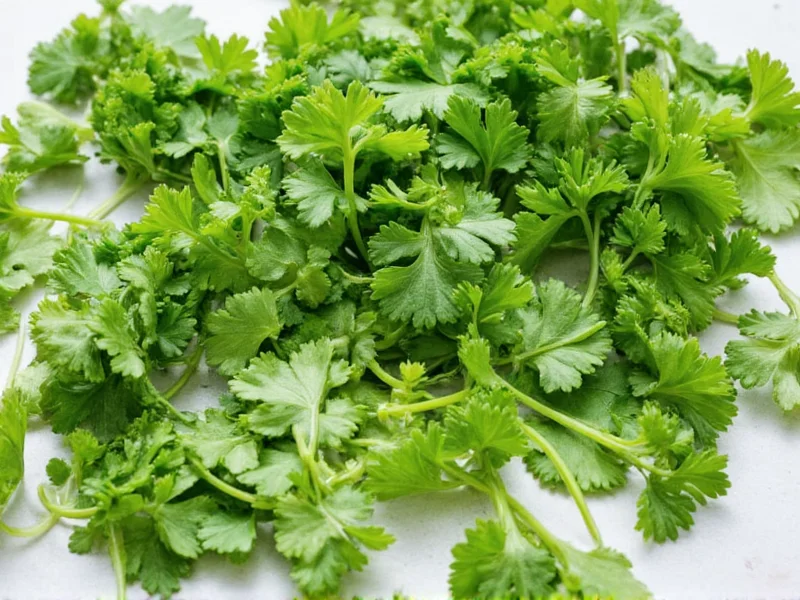Understanding Parsley Substitutes for Every Culinary Need
When your recipe calls for parsley but your herb garden is bare, knowing reliable alternatives can save your dish. Fresh parsley contributes a mild, slightly peppery flavor with grassy notes that enhances both appearance and taste. Whether you're out of this versatile herb or seeking alternatives for dietary reasons, several substitutes work well depending on your specific cooking requirements.
Top Fresh Herb Alternatives to Parsley
When substituting fresh herbs, consider both flavor profile and texture. The best fresh alternatives maintain parsley's mild character without overpowering your dish.
Cilantro: The Citrusy Alternative
Cilantro offers the closest visual match to flat-leaf parsley with its bright green color and similar leaf structure. While cilantro has a more pronounced citrus note, it works well in salsas, salads, and Latin American dishes. Use a 1:1 ratio when substituting, but note that cilantro's flavor diminishes faster when cooked compared to parsley.
Chives: The Delicate Garnish Substitute
For garnishing purposes where parsley's visual appeal matters most, chives provide an excellent alternative. Their mild onion flavor complements potatoes, eggs, and soups without dominating. Chop chives finely and use at a 1:1 ratio for garnishing, though they lack parsley's earthy depth in cooked dishes.
Dill: The Specialized Substitute
Dill works particularly well as a parsley substitute in fish dishes, tzatziki, and cucumber salads. Its feathery appearance resembles parsley, though dill has a distinct anise-like flavor. Use 3/4 the amount of dill compared to parsley, as its flavor is more pronounced. This substitution shines in Scandinavian and Greek cuisine where both herbs commonly appear.
Dried Herb Substitutes for Parsley
When fresh herbs aren't available, dried alternatives become essential. Understanding proper conversion ratios prevents flavor imbalances in your cooking.
| Substitute | Fresh to Dried Ratio | Best For |
|---|---|---|
| Dried parsley | 1 tsp dried = 1 tbsp fresh | General cooking, soups, stews |
| Dried cilantro | 1 tsp dried = 2 tbsp fresh | Mexican dishes, salsas |
| Dried chervil | 1 tsp dried = 1.5 tbsp fresh | French cuisine, delicate sauces |
| Dried tarragon | 1 tsp dried = 1.5 tbsp fresh | Chicken dishes, vinegar-based recipes |
Proper Dried Herb Conversion Techniques
When substituting dried herbs for fresh parsley, remember that dried herbs are more concentrated. The general rule is 1 teaspoon dried herb equals 1 tablespoon fresh herb. Add dried substitutes early in the cooking process to allow flavors to develop, while fresh substitutes typically work best added near the end.
Specialty Substitutes for Specific Dietary Needs
Certain dietary restrictions or flavor preferences may require specialized alternatives to traditional parsley substitutes.
Celery Leaves: The Underrated Alternative
Often discarded, celery leaves offer a remarkably similar flavor profile to parsley with slightly more bitterness. Use them at a 1:1 ratio in soups, stews, and stocks. This zero-waste option works particularly well in mirepoix and bouquet garni preparations.
Arugula: For Peppery Depth
When recipes call for parsley's mild pepperiness, young arugula leaves provide a more intense alternative. Use half the amount of arugula compared to parsley, especially in salads or as a pizza garnish. This substitute works best in Mediterranean dishes where its peppery notes complement tomatoes and olive oil.
Substitutes to Avoid in Common Recipes
Not all herbs make suitable parsley replacements. Some common mistakes include:
- Using rosemary as a parsley substitute (too strong and piney)
- Substituting mint in savory dishes (creates conflicting flavor profiles)
- Replacing parsley with oregano in delicate sauces (overpowers other ingredients)
For Italian dishes specifically, basil makes a poor parsley substitute despite both being common in Mediterranean cuisine. Basil's sweet anise flavor doesn't replicate parsley's grassy notes.
Choosing the Right Substitute for Your Dish
The ideal parsley alternative depends on your specific culinary application:
- Garnishing: Chives or microgreens maintain visual appeal
- Soups and stews: Dried parsley or celery leaves hold up well during cooking
- Fish dishes: Dill provides complementary flavor notes
- Middle Eastern recipes
- Cilantro works best with similar flavor profiles
When substituting in tabbouleh or other parsley-heavy dishes, cilantro remains the closest alternative, though the flavor profile shifts noticeably. For chimichurri sauce, oregano makes a better substitute than parsley alternatives since it's the primary herb in that recipe.











 浙公网安备
33010002000092号
浙公网安备
33010002000092号 浙B2-20120091-4
浙B2-20120091-4